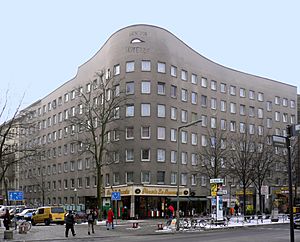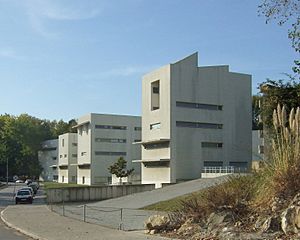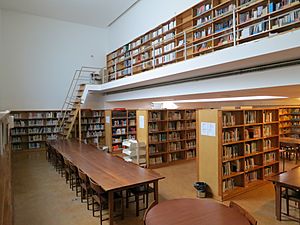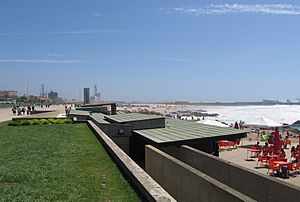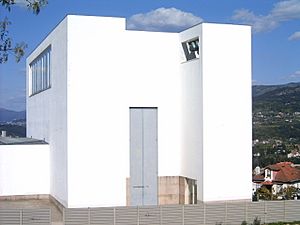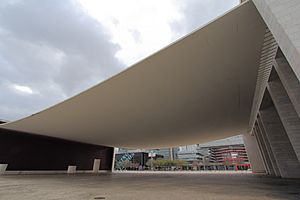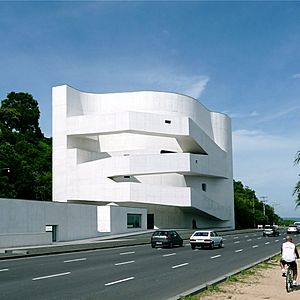Álvaro Siza Vieira facts for kids
Quick facts for kids
Álvaro Siza Vieira
|
|
|---|---|

Álvaro Siza Vieira in 2012
|
|
| Born |
Álvaro Joaquim de Melo Siza Vieira
25 June 1933 (age 92) Matosinhos, Portugal
|
| Nationality | Portuguese |
| Alma mater | University of Porto |
| Occupation | Architect |
| Awards | Pritzker Prize (1992), Royal Gold Medal (2009), UIA Gold Medal (2011), Golden Lion for lifetime achievement (2012), National Architecture Award of Spain (2019) |
| Buildings | Faculty of Architecture, Porto |
Álvaro Joaquim de Melo Siza Vieira, born on June 25, 1933, is a famous Portuguese architect and teacher. He is known around the world as Álvaro Siza. In Portugal, people often call him Siza Vieira. He has designed many amazing buildings.
Contents
Early Life and Schooling
Siza was born in Matosinhos, a small town by the sea near Porto, Portugal. He studied architecture at the University of Porto. He finished his studies in 1955. While at school, he met his wife, Maria Antónia Siza. They had a daughter and a son together.
Álvaro Siza's Career in Architecture
Siza started his own architecture office in Porto in 1954. This was even before he finished his studies! He built his first four houses in Matosinhos that same year.
Working with Other Architects
Siza became a well-known teacher at the Porto School of Architecture. He worked with another famous architect named Fernando Távora from 1955 to 1958. He also teamed up with Eduardo Souto de Moura on big projects. These included Portugal's main buildings for Expo '98 in Lisbon and Expo 2000 in Hannover. They also worked on the Serpentine Pavilion in 2005.
Siza's Design Style
People often describe Siza's work as "poetic modernism". This means his buildings are modern but also have a beautiful, artistic feel. His designs are also seen as minimalist. This is because they focus on simplicity and balance.
Key Projects and Buildings
One of Siza's first projects to get a lot of attention was a public swimming pool complex. He built it in the 1960s for Leça da Palmeira. This place is a fishing town and summer resort. The pools and changing rooms are built right into the natural rocks by the sea. They offer amazing views.
After a big change in Portugal in 1977, Siza designed a housing project in Évora. It included 1,200 low-cost homes. He also helped rebuild the historic center of Lisbon, called Chiado. This area was badly damaged by a fire in 1988.
Many of his most famous buildings are in his hometown of Porto. These include the Boa Nova Tea House (1963) and the Faculty of Architecture (1987–93). He also designed the Serralves Museum of Contemporary Art (1997).
From the mid-1970s, Siza worked on many public housing projects, pools, and university buildings. He also helped restore old buildings in Cidade Velha in Cape Verde. In 2014, he designed a new entrance for the famous Alhambra in Spain. In 2019, Siza worked on his first project in the United States. It was a tall apartment building in Manhattan, New York. In 2020, he designed four buildings at the Taifong Golf Club in Taiwan.
Teaching Architecture
Siza taught at the Porto School of Architecture from 1966 to 1969. He returned to teach there in 1976. He has also been a visiting professor at many other universities. These include Harvard University and the University of Pennsylvania.
Álvaro Siza's Legacy
In 2014, Siza decided to give most of his architectural drawings and plans to the Canadian Centre for Architecture (CCA) in Montreal, Canada. This helps make his work available for others to study. He also gave some project archives to foundations in Lisbon and Porto.
Awards and Recognition
In 1992, Siza won the very important Pritzker Prize. This award is like the Nobel Prize for architects. He won it for his work on rebuilding the Chiado area in Lisbon after the fire.
He has received many other awards too. These include the Mies van der Rohe Award for European Architecture in 1988. He also won the RIBA's Royal Gold Medal in 2009. In 2012, he received the Golden Lion for lifetime achievement at the Venice Architecture Biennale. In 2019, he became the first non-Spanish architect to win the National Architecture Award of Spain.
Many universities have given Siza honorary doctorates. He is also a member of important groups like the American Academy of Arts and Sciences.
Selected Projects
Some of Siza's notable works include:
- The Iberê Camargo Foundation in Brazil.
- The Serralves Museum in Portugal.
- The New Orleans building in the Netherlands.
Exhibitions of Siza's Work
Siza's work has been shown in many exhibitions around the world. These shows help people learn about his designs and ideas.
- 2012: Alturas de Machu Picchu: Martín Chambi – Álvaro Siza at Work, in Montreal.
- 2014-2017: Visions of the Alhambra, shown in Berlin, Weil am Rhein, Granada, Oslo, Toronto, and Porto.
- 2017: Architecture on Canvas, in Chaves.
- 2018: AlfaroSiza, in Valencia.
- 2019-2020: SIZA – Unseen & Unknown, shown in Berlin and Porto.
See also
 In Spanish: Álvaro Siza para niños
In Spanish: Álvaro Siza para niños


